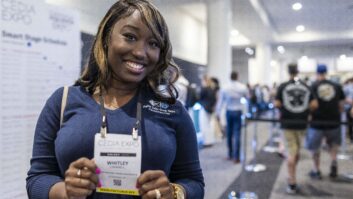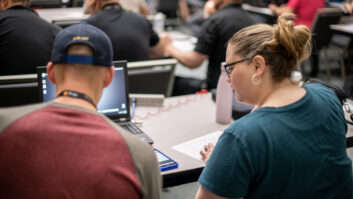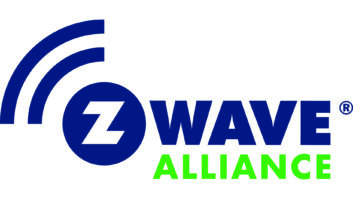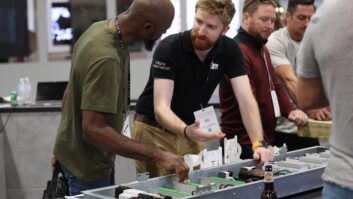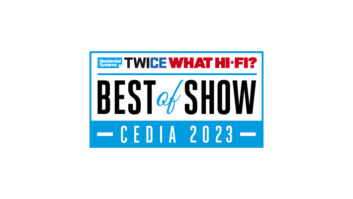Another CEDIA is in the bag! Hopefully you or members of your company had a chance to attend and experience the convention first hand.
Once again, San Diego was a terrific host city, with terrific weather, many great places to eat, easy navigation either on foot, Uber, or using one of the many powered scooters lying around, and a massive selection of fantastic craft beer to wind down after a long day on the show floor. (As a craft beer aficionado, I put this post of my top 10 San Diego craft beers together…)
This is my 20th CEDIA, and it amazes me how the show continues to be fresh, relevant and offer tons of beneficial reasons for attending. Here is the first half of what really stood out to me at this year’s show.
See also: 2018 CEDIA Expo Best Of Show Winners Announced
1. 4K Projection
We’ve been dancing around this for a while, but this CEDIA appears to be the year where 4K projection is finally reached the tipping point of becoming the de facto projection technology. There were 4K models on display from Sony, JVC, Epson, Optoma, LG, DPI and Barco. (If there were others that I missed, I apologize.)
Sony launched three new true 4K projectors, bringing its 4K line-up to six models ranging from $5000 to $60,000. All of the new models announced feature full 18 Gbps HDMI inputs, offer vertical stretch for 4K content for use with outboard anamorphic lenses, support 3D, and include upgrades to Sony’s 4K Reality Creation processing.
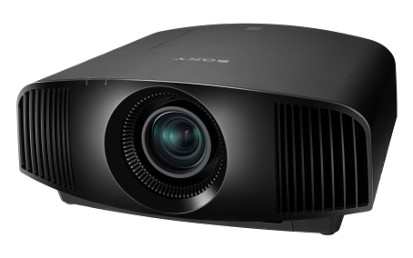
The entry-level VPL-VW295ES will sell for $5000 and has 1500 lumens, the step up VPL-VW695ES moves to 1800 lumens, adds a dynamic iris for improved contrast, and has lens memory, while the VPL-VW995ES will cost $35,000 and utilize a laser light engine with dynamic iris to deliver 2200 lumens as well as incorporating Sony’s flagship ARC-F with new digital focus enhancement for the sharpest images the company has ever delivered.
JVC finally joins Sony in the true, native 4K projection camp, also coming to CEDIA with three new models. (Technically six models as JVC uses different model numbers for its distribution channels.) The new units will all be available in October and will include the DLA-NX5/DLS-RS1000 at $6000, the DLA-NX7/DLS-RS2000 at $8000, and the flagship DLA-NX9/DLS-RS3000 selling for $18,000. All models feature a new Auto Tone Mapping function to improve HDR display and include the high native and dynamic contrast ratios for which JVC is known. The NX9/RS3000 will be THX 4K Display certified and utilize the same 18-element, 16-group all-glass lens featured on JVC’s flagship BLU-Escent projector.
At the more affordable end of the scale — sub $2500 — Epson shows the new Pro Cinema 4050, which uses pixel shifting to deliver 4K onscreen resolution. The demonstration was pretty impressive, showing off notable HDR highlights via the projector’s 2400-lumen output, while still delivering impressive black levels with contrast touted up to 200,000:1.
Whatever your client’s budget or performance needs, 2019 surely looks to be an exciting one for projection technologies, giving integrators plenty of options for delivering killer home theater experiences.
2. 8K is Here
Sciacca (to CE Industry): [Waves hand] There is no need for anything beyond 4K.
CE Industry: Weak-minded fool! He’s using an old visual acuity mind trick! Your mind powers will not work on me, boy!
If it feels like we’re finally getting to the point where 4K displays are hitting on all cylinders, with fantastic contrast levels, terrific HDR video and wide color gamuts with mass-market pricing, then you know that the consumer electronics industry is already looking forward to the next big thing. Never mind that we still have virtually no broadcast 4K content, or that the streaming content is highly compressed. Because 8K is not only coming, it’s here. Besides hyper-clarity, the additional pixels bring an almost 3D look, delivering immense depth and dimension, along with intense color saturation.
Samsung’s new full 8K resolution Q900R panels will be available in Europe in 65- and 75-inch models, but here in the States — where bigger is better, naturally — we’re getting an 85-inch version starting next month. Sure, the suggested $15,000 MSRP isn’t going to be for everyone, but the 4000-nit peak brightness produced images that were simply stunning. Also, with Samsung’s One Connect Box, you will be able to upgrade the TV to support new HDMI formats as they become available, ensuring the TV can handle the full might and power of HDMI 2.1 when it arrives.
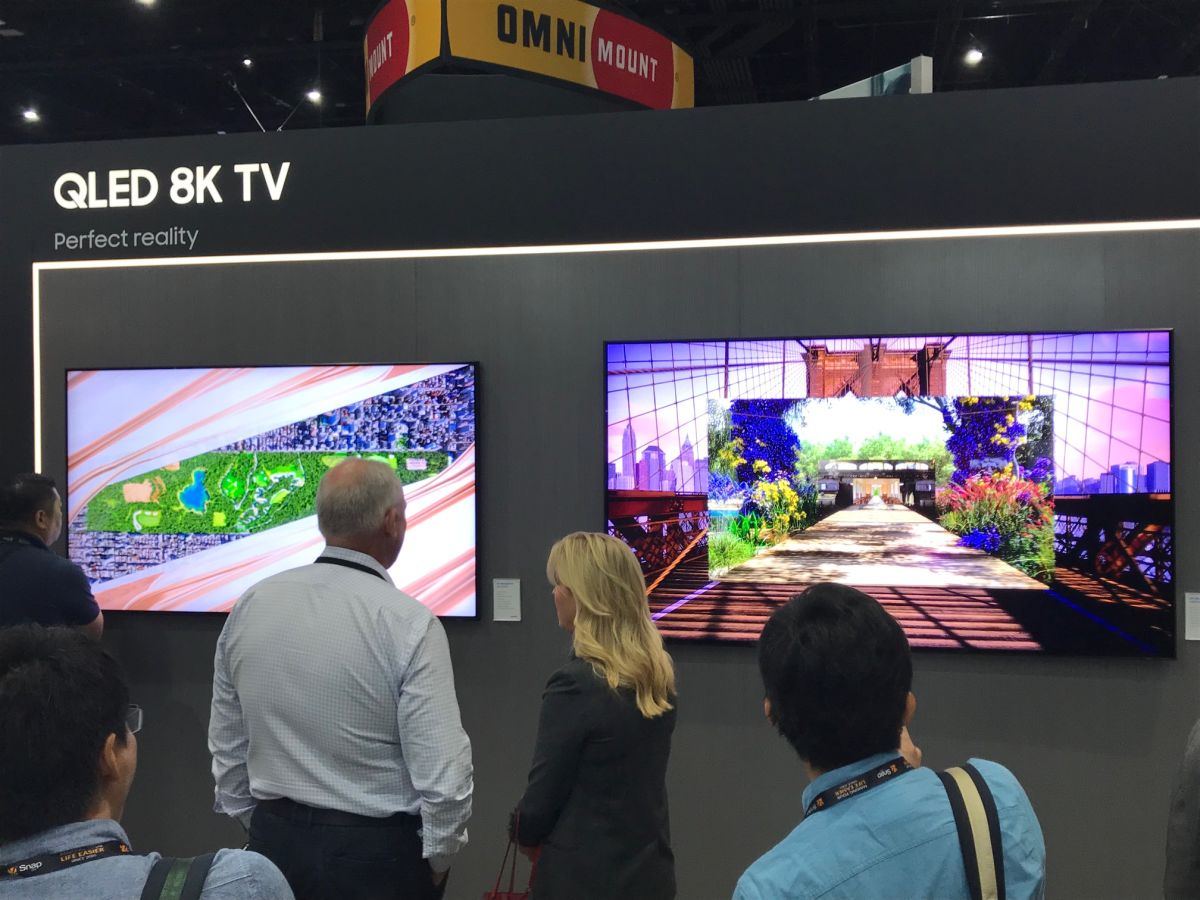
Not to be left behind, several projector manufacturers also showed a variety of 8K solutions ranging from affordable to the “costs more than your house” variety. This makes the most sense, as the enhanced 33-plus million pixels will be far more appreciated on large screen sizes than direct-view sets. JVC is using a version of its e-shift technology on its new NX9/RS3000 (mentioned above) to get 8K resolution onscreen. During the demo, the company displayed true 8K content, scaled down to 4K, then e-shifted back to 8K on screen. Sony showed a solution that involved using a dual stack of its new VPL-VW995 laser projectors (also mentioned above) along with some special-sauce processing to align and focus the images to deliver 8K resolution.
See also: 5 Things You Need To Know About IoT For The Home
Finally, there was Digital Projection (DPI) with its Insight Laser 8K projector. According to the company, this unit uses “dozens and dozens” of lasers to project a massive 25,000 ANSI lumens. During the demo DPI was showing true 8K content that was truly phenomenal, with micro-resolution detail you wouldn’t think possible.
3. Atmos is Ubiquitous
We’re now deep into Dolby Atmos “being a thing” and it was everywhere at CEDIA. It was included in every theater demonstration I saw, including those by at least four soundbar manufacturers. By far the most supported — and demonstrated — format is 7.1.4, with every receiver manufacturer having a capable model, with many (Denon, Marantz, Pioneer, Onkyo, Integra) companies offering 11-channels models for full 7.1.4 performance in a single chassis. And, different from previous past, I can’t recall any manufacturer demonstrating Atmos-enabled/upfiring speakers (except for soundbars), opting instead for overhead speakers to handle the height effects.
However, for larger, luxury theaters, higher-end processors like Trinnov, JBL Synthesis, Steinway Lyngdorf, Datasat, Acurus and StormAudio are pushing the channel count boundaries upwards to the very limits — 34 channels plus LFE in a 24.1.10 array — of what Dolby supports. These higher channel counts provide a more cohesive soundfield, especially in larger theaters with multiple rows of seating, ensuring that objects move convincingly and seamlessly around the room.
9 Of The Coolest Booths At CEDIA Expo
Those looking to go beyond 7.1.4 for under $10,000 had no options before this year, but now there are at least three. Both the new Denon AVR-X8500H receiver and Marantz AV-8805 preamp feature processing for up to 13-channels (7.1.6 or 9.1.4 layouts). Beyond 13 channels, the new Emotiva RMC-1 will support 9.1.6 out of the box and have expansion module slots that can go up to 24-channels. Marantz — and other manufacturers — had the AV-8805 on display, with the six overhead height speakers providing terrific coverage for the multiple rows of seating in the demo theater.
4. Outdoor Living Trend Continues
If your outdoor A/V installation solutions still involve selling a few rocks or surface mount speakers and sticking a TV on the porch and hoping for the best, then you are seriously missing one of the biggest recent trends to come to the CEDIA channel!
Enhanced outdoor audio speaker systems featuring multiple 70-volt or 8-ohm speakers with subwoofers for more even coverage across a large listening area first started appearing a few years ago, but now they are available in different sizes, configurations and performance levels by many manufacturers. New systems were on display this CEDIA from many manufacturers, including Origin Acoustics, which showed its innovative Bollard speakers with a subwoofer concealed in each speaker along with the company’s first rock speakers; Rockustics’ Cherry Bomb, which also combines a subwoofer in the same cabinet as the midrange and tweeter for full-range audio; SpeakerCraft’s Terrazza Series Landscape speaker system that offers more affordable performance with either an in-ground on hardscape subwoofer option; Monitor Audio’s Garden Series subwoofer; and additions to Revel’s Extreme Climate Series.
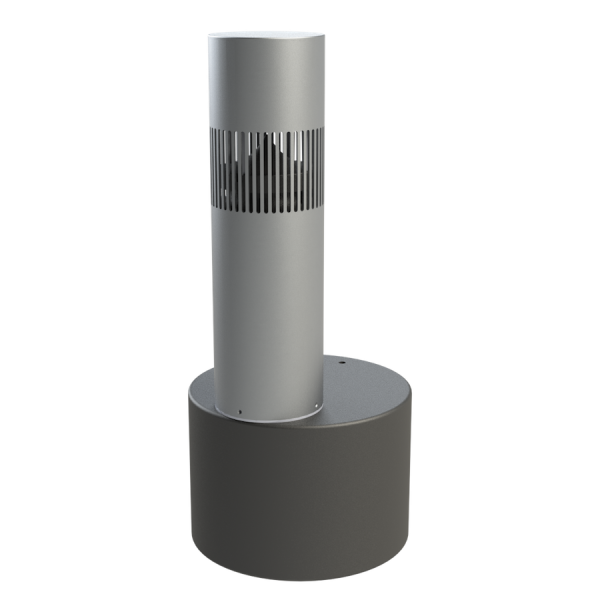
In the outdoor display front, both SunBrite and Seura bowed new models. SunBrite upgraded its affordable Veranda series of 4K UHD outdoor TVs, giving it a sleeker, thinner-bezel look, increasing the brightness by 30 percent to 400 nits, adding HDR support, and including complete IP control. Seura’s new Shade Series will feature models in 55, 65 and 75 inches, with all models featuring HDR and 10-zone dimming. Additionally, the Seura sets are said to be 25 percent brighter than other full-shade outdoor models, with 2.5-times the audio output with a 50-watt RMS speaker system and a best-in-class warranty.
Another very cool outdoor audio development is MSE’s OS-440, the world’s first weatherproof smart amplifier. This IP55 certified amp is completely weatherproof, and can deliver 80 watts into 2 channels at 8 ohms, or 40 watts into 4 channels at 4 ohms. The 440 has both analog and TOSLINK digital audio inputs for connecting existing sources, and also has onboard Bluetooth and WiFi, as well as Google Chromecast built in for easy streaming. It can also be voice-controlled via either Amazon Alexa or Google Assistant.
5. The Show Itself
This marked the first time that CEDIA was completely run by new owners, Emerald Expositions, following the event’s acquisition in January 2017. So, how do you think they did?
For me, I felt they did a mostly great job of running the show, and that the crowds and energy at this CEDIA were some of the best in years. I heard similar comments from many manufacturers, some saying that this was the busiest CEDIA in recent memory, that not only were the crowds bigger, but that the “quality” of attendees was better, with the majority of people visiting booths looking for real business answers or solutions and “not just looking to grab some free T-shirt or screwdriver handout.”
See also: Rayva Turns Up The Volume On Turnkey Home Theater At CEDIA
It also appeared that the convention center was lengthened a bit, which made for more space, and that the aisle ways were widened, making it far easier to navigate. And if the aisles felt uncrowded at times, it was likely because the attendees were in booths.
My only real criticism of the new “CEDIA” was the press room. Since many of you have likely never been inside CEDIA’s press room, you probably don’t have any baseline feelings about what a press room would or wouldn’t be. In years past, the press room was a fantastic place to retreat to work, interview and file stories, with desks of computers available for use, multiple printers for printing notes, plenty of strip power outlets at every table for everyone to charge their devices while working, and press releases from numerous manufacturers attending the show lining the walls. This CEDIA press room had none of these things, making it a press room almost entirely devoid of any press people whatsoever. Here’s to hoping that Emerald will get things sorted out for Denver.





